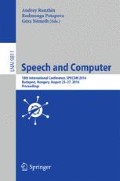Abstract
Statistical parametric speech synthesis has overcome unit selection methods in many aspects, including flexibility and variability. However, the intonation of these systems is quite monotonic, especially in case of longer sentences. Due to statistical methods the variation of fundamental frequency (F0) trajectories decreases. In this research a random forest (RF) based classifier was trained with radio conversations based on the perceived variation by a human annotator. This classifier was used to extend the labels of a phonetically balanced, studio quality speech corpus. With the extended labels a Long Short-Term Memory (LSTM) network was trained to model fundamental frequency (F0). Objective and subjective evaluations were carried out. The results show that the variation of the generated F0 trajectories can be fine-tuned with an additional input of the LSTM network.
Access this chapter
Tax calculation will be finalised at checkout
Purchases are for personal use only
References
Zen, H., Tokuda, K., Black, A.W.: Statistical parametric speech synthesis. Speech Commun. 51, 1039–1064 (2009)
LeCun, Y., Bengio, Y., Hinton, G.: Deep learning. Nature 521(7553), 436–444 (2015)
Zen, H., Senior, A., Schuster, M.: Statistical parametric speech synthesis using deep neural networks. In: ICASSP, pp. 7962–7966 (2013)
Fan, Y., Qian, Y., Xie, F.-L., Soong. F.K.: TTS synthesis with bidirectional LSTM based recurrent neural networks. In:. Interspeech, pp. 1964–1968 (2014)
Németh, G., Fék, M., Csapó, T.G.: Increasing prosodic variability of text-to-speech synthesizers. In: INTERSPEECH, pp. 474–477 (2007)
Jia, H, Tao, J, Wang, X.: Prosody variation: application to automatic prosody evaluation of Mandarin speech. In: Proceeding Speech Prosody, pp. 547–550 (2008)
Gahlawat, M., Malik, A., Bansal, P.: Expressive speech synthesis system using unit selection. In: Prasath, R., Kathirvalavakumar, T. (eds.) MIKE 2013. LNCS, vol. 8284, pp. 391–401. Springer, Heidelberg (2013)
Gustafson, K., House, D.: Fun or boring? A web-based evaluation of expressive synthesis for children. In: INTERSPEECH, pp. 565–568 (2001)
Camacho, A.: Swipe: a sawtooth waveform inspired pitch estimator for speech and music. Doctoral dissertation at the University of Florida, pp. 47–86 (2007)
Hochreiter, S., Schmidhuber, J.: Long short-term memory. Neural Comput. 9(8), 1735–1780 (1997)
Pascanu, R., Mikolov, T., Bengio, Y.: On the difficulty of training recurrent neural networks. arXiv preprint arXiv:1211.5063 (2012)
Garner, P.N., Cernak, M., Motlicek, P.: A simple continuous pitch estimation algorithm. IEEE Signal Process. Lett. 20(1), 102–105 (2013)
Zhang, Q., Soong, F. K., Qian, Y., Yan, Z., Pan, J., Yan, Y.: Improved modeling for F0 generation and V/U decision in HMM-based TTS. In: ICASSP, pp. 4606–4609 (2010)
Drugman, T., Stylianou, Y.: Maximum voiced frequency estimation: exploiting amplitude and phase spectra. IEEE Signal Process. Lett. 21(10), 1230–1234 (2014)
Csapó, T.G., Németh, G., Cernak, M.: Residual-based excitation with continuous F0 modeling in HMM-based speech synthesis. In: Dediu, A.-H., Martín-Vide, C., Vicsi, K. (eds.) SLSP 2015. LNCS, vol. 9449, pp. 27–38. Springer, Heidelberg (2015). doi:10.1007/978-3-319-25789-1_4
Olaszy, G.: Development and services of a Hungarian precisely labeled and segmented, parallel speech database, (in Hungarian), Speech Res., pp. 261–270 (2013)
Chollet, F.: Keras: Theano-based deep learning library, https://github.com/fchollet, Documentation: http://keras.io (2015)
ITU-T recommendation p. 800: Methods for subjective determination of transmission quality (1996)
Laskowski, K., Heldner, M., Edlund, J.: The fundamental frequency variation spectrum. In: FONETIK-2008, pp. 29–32 (2008)
Acknowledgments
We would like to thank to Mátyás Bartalis for his help in creating the subjective listening test and to the listeners for participating in it. Bálint Pál Tóth gratefully acknowledges the support of NVIDIA Corporation with the donation of an NVidia Titan X GPU used for his research. This research is partially supported by the Swiss National Science Foundation via the joint research project (SCOPES scheme) SP2: SCOPES project on speech prosody (SNSF n° IZ73Z0_152495-1).
Author information
Authors and Affiliations
Corresponding author
Editor information
Editors and Affiliations
Rights and permissions
Copyright information
© 2016 Springer International Publishing Switzerland
About this paper
Cite this paper
Tóth, B.P., Szórádi, B., Németh, G. (2016). Improvements to Prosodic Variation in Long Short-Term Memory Based Intonation Models Using Random Forest. In: Ronzhin, A., Potapova, R., Németh, G. (eds) Speech and Computer. SPECOM 2016. Lecture Notes in Computer Science(), vol 9811. Springer, Cham. https://doi.org/10.1007/978-3-319-43958-7_46
Download citation
DOI: https://doi.org/10.1007/978-3-319-43958-7_46
Published:
Publisher Name: Springer, Cham
Print ISBN: 978-3-319-43957-0
Online ISBN: 978-3-319-43958-7
eBook Packages: Computer ScienceComputer Science (R0)

